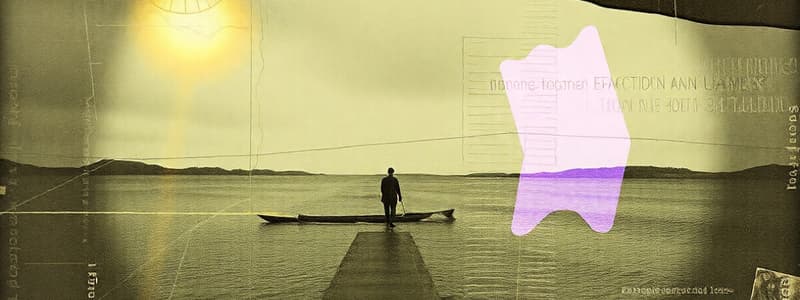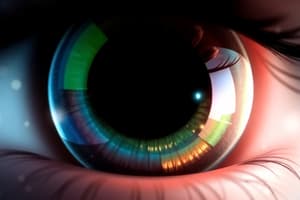Podcast
Questions and Answers
When the first and second focal lengths are equal numerically?
When the first and second focal lengths are equal numerically?
- When the lens is placed on the surface of water
- When the lens is placed on the surface of oil
- When the lens is placed inside water (correct)
- None of the above
Which lens has a virtual focus?
Which lens has a virtual focus?
- Short focal length lens
- Long focal length lens
- Bi-concave lens (correct)
- Bi-convex lens
What will be the focal length of a double convex lens of glass when immersed in water?
What will be the focal length of a double convex lens of glass when immersed in water?
- 40 cm
- -10 cm
- 10.0 cm (correct)
- 7.5 cm
How does the focal length of a thick convex lens compare to that of a thin convex lens?
How does the focal length of a thick convex lens compare to that of a thin convex lens?
Where will the image be formed when an object is placed at the focus of a concave lens?
Where will the image be formed when an object is placed at the focus of a concave lens?
The magnification of which type of lens is always less than 1?
The magnification of which type of lens is always less than 1?
If a lens deviates light rays towards its center, what is its power?
If a lens deviates light rays towards its center, what is its power?
In order to achieve a magnification of (– 3) with a convex lens, the object should be placed:
In order to achieve a magnification of (– 3) with a convex lens, the object should be placed:
What happens to an oblique incident ray on a convex lens when the refractive index of the medium relative to the lens is 1?
What happens to an oblique incident ray on a convex lens when the refractive index of the medium relative to the lens is 1?
To obtain a distinct image of a distant object on a screen using a convex lens, where should the lens be moved?
To obtain a distinct image of a distant object on a screen using a convex lens, where should the lens be moved?
Which convex lens among P, Q, R, and S, with focal lengths of 20 cm, 15 cm, 5 cm, and 10 cm respectively, has the greatest power?
Which convex lens among P, Q, R, and S, with focal lengths of 20 cm, 15 cm, 5 cm, and 10 cm respectively, has the greatest power?
What will be the focal length of a double convex lens when it is immersed in water, given that it has a focal length of 10 cm in air?
What will be the focal length of a double convex lens when it is immersed in water, given that it has a focal length of 10 cm in air?
What type of image does a concave lens primarily form?
What type of image does a concave lens primarily form?
When an object moves from a large distance towards a concave lens, where does the image shift?
When an object moves from a large distance towards a concave lens, where does the image shift?
What type of lens does a person suffering from long-sightedness, or Hypermetropia, wear?
What type of lens does a person suffering from long-sightedness, or Hypermetropia, wear?
What happens when a convex lens is placed in a fluid with a higher refractive index than the lens?
What happens when a convex lens is placed in a fluid with a higher refractive index than the lens?
Flashcards
When does an oblique incident ray on a convex lens pass undeviated?
When does an oblique incident ray on a convex lens pass undeviated?
The refractive index of the medium is the same as the refractive index of the lens. Therefore, the light rays pass through the lens without any deviation.
When the image is blurred on a screen, what should be done to the lens?
When the image is blurred on a screen, what should be done to the lens?
To obtain a distinct image, the lens should be moved away from the screen. This is because, as the object moves closer to the lens, the image moves away from the lens and towards the screen.
Which lens has the greatest power amongst lenses with focal lengths of 20 cm, 15 cm, 5 cm, and 10 cm?
Which lens has the greatest power amongst lenses with focal lengths of 20 cm, 15 cm, 5 cm, and 10 cm?
Power of a lens is inversely proportional to its focal length. The lens with the shortest focal length will have the greatest power.
What happens to the focal length of a convex lens when immersed in water?
What happens to the focal length of a convex lens when immersed in water?
Signup and view all the flashcards
What type of image does a concave lens form?
What type of image does a concave lens form?
Signup and view all the flashcards
Where does the image shift when the object moves closer to a concave lens?
Where does the image shift when the object moves closer to a concave lens?
Signup and view all the flashcards
What type of lens is used to correct Hypermetropia (longsightedness)?
What type of lens is used to correct Hypermetropia (longsightedness)?
Signup and view all the flashcards
Name the point on the principal axis where incident ray emerges parallel after passing through the optical center.
Name the point on the principal axis where incident ray emerges parallel after passing through the optical center.
Signup and view all the flashcards
What is Focal Length?
What is Focal Length?
Signup and view all the flashcards
How does the focal length of a lens change when immersed in a medium?
How does the focal length of a lens change when immersed in a medium?
Signup and view all the flashcards
What is a convex lens?
What is a convex lens?
Signup and view all the flashcards
What is a concave lens?
What is a concave lens?
Signup and view all the flashcards
What is the power of a lens?
What is the power of a lens?
Signup and view all the flashcards
What is nearsightedness?
What is nearsightedness?
Signup and view all the flashcards
What is farsightedness?
What is farsightedness?
Signup and view all the flashcards
What is magnification?
What is magnification?
Signup and view all the flashcards
Study Notes
Refraction through Lenses
- Focal Length Equality: The first and second focal lengths are numerically equal (f₁ = f₂) when the lens is placed on the surface of water.
- Virtual Focus: A bi-concave lens has a virtual focus.
- Focal Length in Different Mediums: A double convex lens with a 10cm focal length in air will have a different focal length when immersed in water. The provided options show a range of values, but the specific answer depends on the refractive index of the glass and water in question.
- Thick vs Thin Convex Lenses: The focal length of a thick convex lens is less than that of a thin convex lens.
- Concave Lens Image Location: An object placed at the focus of a concave lens will produce an image at infinity.
- Lens Magnification: The magnification of a lens is always less than 1.
- Parallel Light through Convex Lens: A beam of parallel light rays incident obliquely on a convex lens converges at a point after refraction.
- Lens Power and Deviation: If a lens deviates a ray towards its center, the power is positive. If it deviates a ray away, the power is negative.
- Hypermetropia (Long Sightedness): Hypermetropia is corrected by using convex lenses.
- Lens Power and Focal Length: A convex lens of 0.25m focal length has 4 dioptre power.
- Magnification with Convex Lens: To obtain a magnification of -3 with a convex lens, the object must be placed between the optical center and the focus.
- Object Distance and Image Size (Convex Lens): When an object is placed between F and 2F of a convex lens, the image will be real and enlarged.
- Refractive Index and Ray Deviation: When the refractive index of the medium relative to the lens is 1 (equal), an oblique incident ray on a convex lens will pass undeviated.
- Blurred Image and Lens Movement: A blurred image on a screen due to a convex lens can be corrected by moving the lens towards or away from the screen (depending on the object's position).
- Lens Power Comparison: The power of a lens is inversely proportional to its focal length. The shorter the focal length, the greater the power.
- Focal Length in Water (Convex Lens): A double convex lens of glass with a 10 cm focal length in air, will have a different focal length when immersed in water. Among the given options, it is 7.5cm (or close to it)
- Concave Lens Images: A concave lens only forms virtual images.
- Object Distance & Concave Lens: When the object moves closer to a concave lens, the image shifts from the focus toward the optical center (getting closer to the lens).
- Hypermetropia Correction: Hypermetropia (long sightedness) is corrected with convex lenses.
- Focal Points and Principal Axis: The focal point (or focus) is a point on the principal axis of a lens. Light rays parallel to the principal axis, after passing through the lens, converge (or appear to diverge from) the focal point.
- Lens Properties (Image Characteristics): The type of image (enlarged/diminished, real/virtual, upright/inverted) produced by a lens depends on the object's distance from the lens and the lens' type.
- Galileo Telescope: Utilized as a terrestrial telescope and to magnify images.
- Refractive Index and Lens Behavior: When a convex lens is placed in a fluid with a higher refractive index than the lens, the parallel light rays bend less. Sign convention rules for u (object distance), f (focal length), and v (image distance) are applied in lens calculations.
- Optical Center and Lens Behavior: Light passing exactly through the center of a thin lens or a thin concave lens will not be affected. Thick lens interaction may vary.
- Ray Diagrams: Ray diagrams should be drawn both for a simple microscope and for a myopic eye correction.
Studying That Suits You
Use AI to generate personalized quizzes and flashcards to suit your learning preferences.




